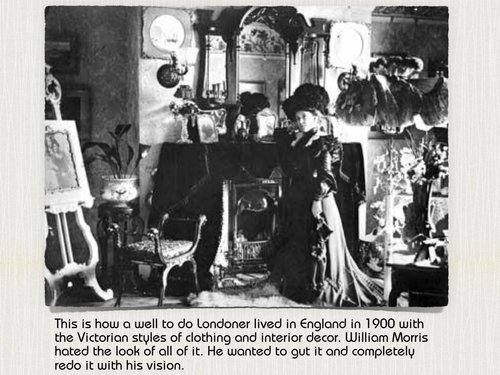

































The author is a retired attorney but still producing artist.
This is a powerpoint presentation about Arts and Crafts Movement, led by William Morris in London, England, and his followers, in the UK, America, and later Japan. To best assess this presentation, study the actual slides on exhibit on this page.
TEXT EXCERPT:
Any discussion of the Arts & Crafts movement must always begin with William Morris. It would never have taken place without him.
Morris went to Oxford with Edward Burne-Jones. They both intended on becoming ministers. However, they met Gabriel Dante Rossetti and the rest of the Pre-Raphaelite artists. They were so bowled over that they changed their life path so as to both became artists.
The two men remained life long friends and sometime collaborators. Burne-Jones became a leading painter while Morris single handedly led the Arts & Crafts movement in England.
Morris gave up painting so that he could pursue design. He could design just about anything. His myriad textile designs, his furniture and stained glass windows are well known.
Morris believed that industrialization was an alienating and dehumanizing process. His goal was to unite the arts for the decoration of the home with simple forms echoing nature. This was to reverse alienation and dehumanization.
His Arts and Crafts movement did not promote a particular style. He stuck with his overall goal: as machines replaced workers, the Arts and Crafts movement advanced the handmade and the designer as craftsman.
The movement spread to America but remained linked to the British movement and Morris.
Like most movements, this one waned over time, especially as the cities and use of technology rose. Handmade Arts and Crafts movements are frequently revived throughout time because of the societal need to counter alienation and dehumanization of people.
One realization Morris did not achieve was making art for the common man per his socialist ideals. However, he achieved the overall goal of its trickling down to the middle class person.
Morris was like a fashion designer who creates the couture line. Couture is very expensive and has the best materials and hand work. But it trickles down to the middle by others who use it to make their own variations of it to sell in the market place.
Today many of us live like Morris wanted us to live. We have made our homes comfortable havens and we are dressed comfortably within them, enjoying them. Around us at least in part are objects that we’ve bought in art galleries, art fairs, craft shows and the like. Or we’ve even made those objects ourselves.
Something went wrong, please try again later.
This resource hasn't been reviewed yet
To ensure quality for our reviews, only customers who have purchased this resource can review it
Report this resourceto let us know if it violates our terms and conditions.
Our customer service team will review your report and will be in touch.